Army Lists
Regimental Standards and Cap Badges
1 - 10 | 11 - 20 | 21
- 30 | 31 - 40 | 41
- 50
| 1st Battalion
Scots Guards |
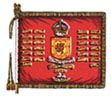 |
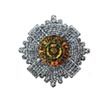 |
|
| King's Colour |
Officer's Cap Badge |
|
The Badge of the Scots Guards is the Star of the Order of the
Thistle, and this is used as a Cap Badge by all ranks. The motto
of the regiment if "Nemo me impune lacessit" (No-one
touches me with impunity). The King's Colours of the two Battalions
are quite different (see 2nd Battalion Scots Guards),
although the same Honours are borne on all the colours of the
regiment. Known formerly as the "Third Regiment of Foot
Guards", the buttons on the Scots Guards coats are placed
in sets of three. |
| 2nd Battalion
Scots Guards |
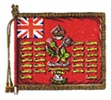 |
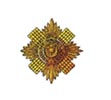 |
|
| King's Colour |
Cap Badge |
|
As can be seen by comparison with 1st Battalion Scots Guards,
the device in the centre of the King's Colour of the two battalions
of the Scots Guards differs, while following the rule of all
the second battalions in the Brigade of Guards, the Union Jack
is placed in the corner. The Regimental March of the Scots Guards
is "Highland Laddie", while their bearskins are easily
distinguished as have no plumes in the sides. Officers and men
alike wear the chequered band on the forage cap. |
| 1st Battalion
Irish Guards |
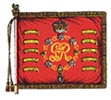 |
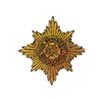 |
|
| King's Colour |
Cap Badge |
|
At present the Irish Guards have one battalion only. The
Badge of the regiment, worn as a Cap Badge by all ranks, is
the Star of the Order of Saint Patrick. The plume in the bearskin
is Irish blue in colour; the cap band of the men's forage
cap is green. The fourth of the Regiments of Foot Guards,
the buttons on the tunics are placed in sets of four. The
regiment was raised after the last South African War, and
the 10 Honours of the Great War appear on the Colours, which
were presented in 1927. |
| 1st Battalion
Welsh Guards |
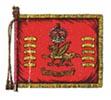 |
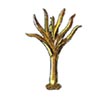 |
|
| King's Colour |
Cap Badge |
|
The warrant for the formation of the Welsh Guards was dated
Feb 26th 1915, and on March 1st (St David's Day) they mounted
the King's Guard for the first time. The 1st Battalion went
out to France on August 17th 1915. The 5th Regiment of Guards,
the buttons are worn in groups of five, while the plume of the
bearskin is white with a green bar. The cap band of the forage
cap is black and the Badge is a leek: the regimental motto is
"Cymru am Byth" (Wales for ever). No. 1 Company is
known as the "Prince of Wales's Company." |
| 1st Battalion
The Queens Royal Regiment (West Surrey) |
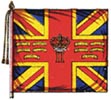 |
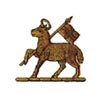 |
|
| King's Colour |
Cap Badge |
|
The 1st Battalion of the Queen's Royal Regiment are another
of the few remainins battalions who still carry the full-sized
old colour with the spear-head top to the pike. The Colour is
very old, and the white silk has faded to a deep yellow. This
Battalion also posesses a third colour, which is green with
the cypher of Catherine of Braganza in the centre. The Cap Badge
is the Paschal Lams, and until recently it bore the name "The
Queen's" on a scroll beneath the wreath. This Badge is
the crest of the Braganza family. |
| 1st Battalion
The King's Own Royal Regiment (Lancaster) |
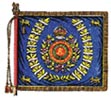 |
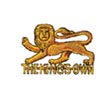 |
|
| Regimental Colour |
Cap Badge |
|
The King's Own Royal Regiment (Lancaster) has bike facings
in full dress, and like other "Royal" regiments
has a blue Regimental Colour. In each corner of the colour
is the lion of England, crowned. The lion is also the Cap
Badge, but here he is not crowned. In the Great War the King's
Own Royal Regiment expanded to 16 Battalions. The pre 1914
Honours, carried by the two Regular and two Territorial battalions
of the regiment number 20, while in the recent war 59 were
gained. |
| 1st Battalion
Royal Warwickshire Regiment |
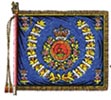 |
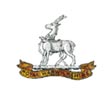 |
|
| Regimental Colour |
Cap Badge |
|
The Royal Warwickshire Regiment, formerly the 6th Foot, is one
of the oldest regiments in the British Army. Its Badge is the
antelope, worn on the headdress and also borne in the center
of the Regimental Colour, which also bears the 16 Honours gained
prior to 1914. In the Great War the regiment numbered thirty
battalions, and gained 70 more Honours, serving in France and
Flauders, in Italy, at Gallipoli, in Mesopotamia, and in Persia.
|
| 2nd Battalion
The Royal Fusiliers |
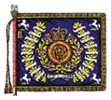 |
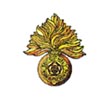 |
|
| Regimental Colour |
Cap Badge |
|
Formerly the 7th Foot, the Royal Fusiliers (City of London Regiment)
has the privilege, shared with the Buffs, Honourable Artillery
Company, Grenadier Guards and Royal Marines, of marching through
the City of London with bayonets fixed. The plume in the busby
is white; as a Royal Regiment the Royal Fusiliers have blue
facings, and this is the field of the Regimental Colour which
has in each corner the White Horse of Hanover. The first four
Battalions of the London Regiment (Territorial Army) are affiliated
to this regiment. (See 1st Battalion
City of London Regiment). |
| 1st Battalion
The King's Regiment (Liverpool) |
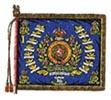 |
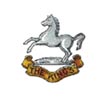 |
|
| Regimental Colour |
Cap Badge |
|
Formerly the 8th Foot, King George I gave it the title of the
"King's Regiment" and his interlaced cypher can be
seen in each of the corners of the Regimental COlour. The motto
of the regiment is that of the old Hanoverian Guelphic Order,
"Nec Aspera Terrent" (Nor do difficulties frighten
us), and the Badge is the White Horse of Hanover. While the
Battle Honours of the Great War are borne on the King's Colour,
all the others, including "Afghanistan 1919", are
on the Regimental Colour. In the Great War the Regiment was
represented by 45 Battalions. |
| 2nd Battalion
Norfolk Regiment |
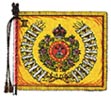 |
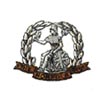 |
|
| Regimental Colour |
Cap Badge |
|
The facings of the Regiment are yellow, and the Regimental Colour
is of this shade. The Regimental Badge is the figure of Britannia,
and this is responsible for a nickname the regiment bears of
the "Holy Boys". During the Peninsular War the Spaniards
imagined that the badge was the figure of the Virgin Mary, and
venerated the wearers. "Rule Britannia" is the regimental
march. Formerly the 9th Foot, the regiment has a most distinguished
record; it found the funeral party which buried Sir John Moore
at Corunna. |
|